Ask Professor Puzzler
Do you have a question you would like to ask Professor Puzzler? Click here to ask your question!
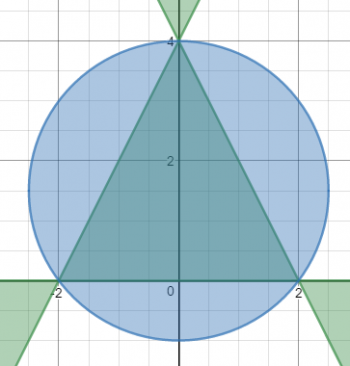
I was up at 3:30 AM today, so I decided to create a Christmas graph for all of my friends. This graph is made up of several inequalities combined with ∩ (intersection) and ∪ (union), and I hope you'll stick with me to the end to see what it looks like. Are you ready?
Let B be the equation: y2 + 0.5y ≤ 0; {-0.5 ≤ x ≤ 0.5}
Let S be the equation: 81x4 - 18x2y2 + 153x2y -326.25x2 + y4 - 17y3 + 108.25y2 - 306y + 324 ≥ 0 {-1/12 ≤ x ≤ 1/12}
Let C1 be the equation: (x - 0.3)2 + (y - 2.5)^2 - 0.0625 ≤ 0
Let T be the equation: 4x2y - y3 + 8y2 - 16y ≤ 0
Let C2 be the equation: x2 + y2 - 3y - 4 ≤ 0
Let O be the equation: [(x - .3)2 + (y - 2.5)2 - 0.02][(x - .3)2 + (y - 2.5)2 - 0.02][(x - .3)2 + (y - 2.5)2 - 0.02] ≥ 0
Let G be the equation: (y - .1 - .2(x - 1)2)(y - .2 - .2(x - 1)2)(y - 1.3 - .2(x - 1)2)(y - 1.4 - .2(x - 1)2)(y - 2.2 - .2(x - 1)2)(y - 2.3 - .2(x - 1)2)(y - 3.2 - .2(x - 1)2)(y - 3.3 - .2(x - 1)2) ≥ 0
Now graph the following:
B ∪ (S ∩ C1) ∪ (T ∩ C2 ∩ O ∩ G)
Okay, okay, this thing is ugly. I'm going to make it a little less ugly by factoring S, B, and T for you. You should be able to factor B and T on your own, but I'm certainly not going to ask anyone to factor S, so I'll just tell you how it factors. If you want to factor B and T on your own, take a moment to do so before reading further.
S factors into: (3x + y - 4.5)(3x - y + 4.5)(3x - y + 4)(3x + y -4) ≥ 0 {-1/12 ≤ x ≤ 1/12}
B factors into y(y + 0.5) ≤ 0; {-0.5 ≤ x ≤ 0.5}
T factors into: y(2x + y - 4)(2x - y + 4) ≤ 0 (see the factoring process)
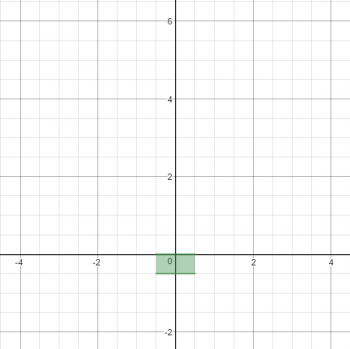
Let's begin by graphing the easiest part of this: B.
Since y(y + 0.5) ≤ 0, we can conclude that y must be between 0 and -0.5, so that the product of the two factors will be less than 0. However, we are also given the stipulation that x is between -0.5 and +0.5, which results in a simple box.
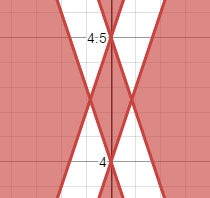
Now let's take a look at the intersection of S and C1. S is a multiplication of four factors which are all linear, and they are in parallel pairs, which means this is going to be a parallelogram. Inside the parallelogram, two of the factors are negative and two are positive, which makes the whole thing positive. The graph looks like the picture to the right.
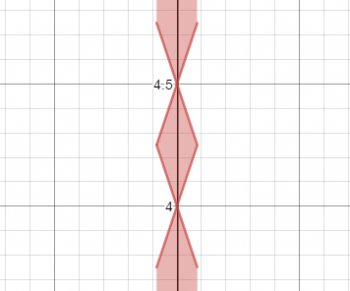
However, we have placed restrictions on the domain of this equation; x has to be between -0.5 and +05, which limits the graph as shown at the right.
We still are not finished with this section of the graph; we have to intersect this with the equation C1. This graph is a circle with center at (0, 4.25), and the interior of the circle is included. This further limits the graph to nothing but the rhombus.
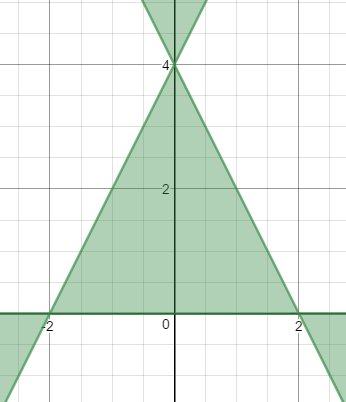
Okay, now the really challenging part. Equation T is very similar to equation S, except that instead of four factors, there are three. Thus, this contains a triangle, and since there are an odd number of factors, and they multiply to something less than or equal to zero, the interior of the triangle is included.

What's next? Well, in case you hadn't guessed C2 is also a circle, and we're intersecting the interior of the circle with the triangle graph, which gives us the next graph.
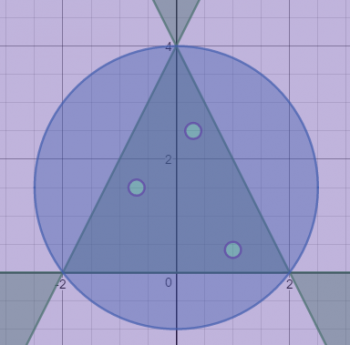
Then we have to deal with that hideous equation O, which appears to be...three circle factors multiplied together. If a point is on the interior of any of those three circles, that factor will be negative, and the other two will be positive, giving a negative result. However, equation O has the product greater than or equal to zero, which means that points satisfying O lie on or outside the three circles. The circles are all pretty small, and they're scattered around inside the triangle. Thus, we have the interior of a triangle, minus three circles, giving us the graph shown here.
What next? The even uglier equation G, which is a series of parabolas multiplied together as shown here.
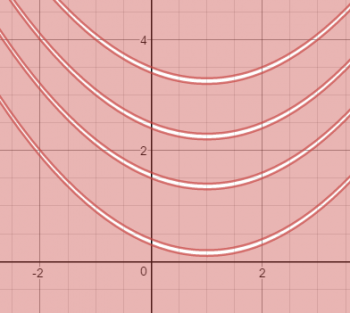
Now, if you were to take all of these and overlay them on top of one another, they would look something like this:
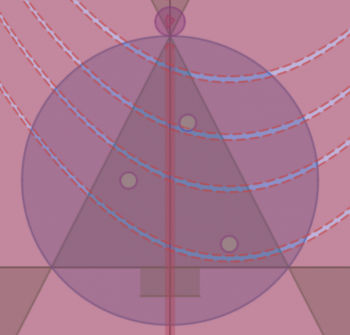
But...we're not overlaying them all; we have to take the intersection of T, C2, O and G, and we also have to take the intersection of S and C1. Then we overlay them (because it is a union of three separate graphs). I've shown them here with distinct colors for each of the three parts combined. Brown for the base (B), green for the tree (Tree ∩ Circle2 ∩ Ornaments ∩ Garland), and yellow for the star (Star ∩ Circle1).

Have a wonderful, Merry Christmas!
Professor Puzzler
P.S. Graph screen captures came from this graphing calculator.
Brock from Canada asks, "Computer programmers use hexadecimal code. I have read and learned your lesson on that but I cant figure out where to put and what the symbols mean when coding. these symbols are #,*,&. what do these symbols mean and where do I insert them when I am doing my programming?"
Hi Brock, thanks for your question. The answer is: it depends on the programming/scripting language you are using. Here are just a few examples. Note that in each example, the symbol (or symbols) that indicate a number is a hexadecimal value is shown in bold text.
If you were programming in the language C or C++, and you wanted to include a hexadecimal number in your program, it might look something like this:
int x = 0xFC;
If you were programming in Javascript your code would look the same.
If you were developing a website using HTML/CSS, and you wanted to provide a color as a hexadecimal value, it would look like this:
background-color:#FF0000;
This is equivalent to:
background-color:rgb(255,0,0);
If you were programming in PHP, you would also use 0x:
$x = 0xA3;
If you were programming in Visual Basic, you could write a hexadecimal number like this:
Dim x as Integer = &h2D
In Pascal (which I learned in college back in the 80s, but haven't used since), a hexadecimal value would be written with a dollar sign:
x := $B8;
Eighth grader Chase, from Canada, asks for examples of things that are horizontal.
Hi Chase,
It's funny that you should ask this question today, because when I was teaching my high school Physics class today, one of my students kept mixing up "horizontal" and "vertical." So before I give examples of horizontal, I thought I'd try to give everyone some helpful hints to remember the difference between horizontal and vertical.
If something is horizontal, that means it's lying down flat, and if it's vertical, it's standing up straight.

So how can you remember the difference? Well, I have two suggestions:
- Remember that the horizon (the place far off in the distance where the land meets the sky) is flat. The horizon is horizontal. And no, it's not a coincidence that the word horizontal contains the word horizon!
- Your vertebrae are the bones in your spine, and your spine stands up straight. Vertebrae, vertical. Both start with with "vert" and both are standing up straight.
So if you can remember one or the other of those things, you should be able to remember the difference between vertical and horizontal.
Okay, so now, to answer your question - what are some things that are horizontal?
- The horizon
- A table top
- A floor
- Roads (except on hills)
- The seat of a chair
- You, when you're sleeping! (and then your vertebrae aren't vertical!)
Some things that are vertical?
- Walls of most buildings
- Doors
- Cliffs
- Towers (except the leaning tower of Piza - that one is neither horizontal nor vertical!)
- Trees
- You, when you're standing up!
Martha asks, "Where does the phrase 'By the Seat of your Pants' come from?"
Well, Martha, I didn't know the answer to this one, so I checked a few different sources, and was able to piece together what seems like a reasonable explanation.
The one thing that all the sources agree on is that it's an old aviation expression. That makes sense, because the full phrase is typically "flying by the seat of your pants," even when the expression is being used in other contexts. For example, if you're playing volleyball, and you don't know how to serve, you wouldn't (probably) say "serving by the seat of my pants" you would still say "flying by the seat of my pants" even though you're not actually flying.
So where does this expression come from? What does it mean to "fly by the seat of your pants?"
Well, in the early days of aviation, the instruments for determining how fast you're going, what angle you're flying at, etc, were not very sophisticated, and in some cases either weren't installed in a plane, or malfunctioned in mid-flight. If that happened, you had to, in an almost literal sense, fly by the seat of your pants.
How would you know if your plane was declined from horizontal? Your "seat" started sliding forward in the pilot's chair. If you felt like you were going to land butt first on the floor, that was a pretty good indicator that you were on a pretty steep descent. Similarly, if you felt like your backside was getting pushed backward, it's a good bet that you're ascending.
What about banking? Well, if you've studied circular motion (or if you've just sat in a car taking a corner quickly!) you know that when the chair you're sitting in takes a corner, your body has a tendency to keep going in a straight line, until you start pressing up against the door, or the side of the chair. So if the plane is banking, you'll feel it in the seat of your pants, because you'll start sliding sideways in the chair.
So pilots who were very experienced could successfully fly a non-instrumented plane based solely on how their derriere was situated in the pilot's chair!
Today, it has taken a more idiomatic meaning. It simply means to do something without planning or organizing, or improvise. To put it another way, it's the same as "winging it," which - interestingly - is not an aviation metaphor. It's a theatrical metaphor, meaning that the person was doing last minute practicing in the stage wings (the offstage area where people waited before performing).
Flying by the seat of your pants. Winging it. Both mean to improvise, but they have vastly different origins!
First of all, I want to make it clear that not only am I not a bowling lane lubricant expert, I'm also not a bowling expert of any kind. I haven't been bowling in years. But your question reminded me of something that used to fascinate me as a teenager. We had a candlepin bowling place in town, and a group of teens from our church would often go there on a weekend evening to bowl.
There was an elderly little man named Harry who was always there. I used to watch him bowl with fascination. While everyone else was racing to the line and giving a powerful swing of the arm, little old Harry would waddle. I kid you not. It was almost painful to watch the snail's pace with which he would approach the line. And he was always holding the ball overhand instead of underhand like everyone else did. Basically he just walked up to the line with his arm hanging limply at his side.
And then, at the last moment, he'd give a flick of his wrist, and that ball would go skidding down the lane, and the pins would go flying. It was a strike every time. That little old man had perfect 300 score cards hung all over the walls of that place, and had won about every local bowling competition.
What was his secret? Well, I'm sure he had more than one, but here's one of Old Harry's secrets: backspin. Notice I said the ball skidded down the lane. Sure, it was rolling, but it was rolling backward, which meant it was really just floating in lane oil. What did that do for him? Consider the two images below.
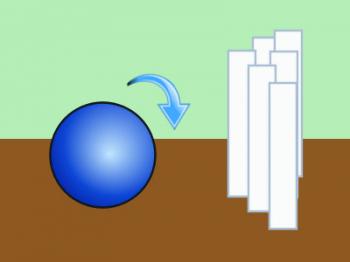
In the first image, we see a ball approaching the pins with a forward spin. You know what that ball is going to do to the pins? It's going to knock them down. But knocking pins down wasn't what happened when Old Harry was bowling. Take a look at the next picture, which shows a bowling ball approaching the pins with a reversed or back spin.
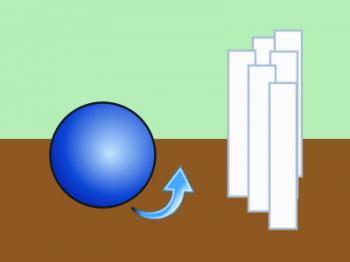
You know what that bowling ball is going to do? Sure, it's going to knock the pins over, but because of its spin direction, it was knocking those pins up. That backspin made the pins go flying everywhere. One pin flying upward would wreak a lot of havoc on the rest of the pins.
So what does this have to do with the lane lubricant? Simple. The lubricant lowers the coefficient of friction on the lane, which allows the ball to spin backward longer, before the spin slows to a stop and reverses to a forward spin (Try it sometime - send the ball down the lane with a backspin, and if the ball is multi-colored, you should be able to see the point at which it stops spinning backward and reverses to a forward spin). So if there was no oil on the lane, Old Harry's bowling ball would have reversed its spin before reaching the pins, and less havoc would have ensued.
And goodness knows, any time we can have havoc, we approve. :)
That coefficient of friction will also make a huge difference when it comes to sideways spins. Depending on how you release the ball, you can make the the ball do a nice "hook" at the last minute, and nail the pins at an angle. This is an important technique.
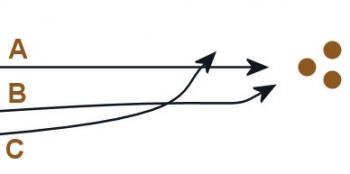
But when the ball hooks isn't just dependent on how you spin it; it's also dependent on the coefficient of friction. If there's no friction whatsoever (entirely theoretical - there's always friction), the spin will be completely irrelevant; the ball will go straight into the pins (line A). If the coefficient of friction is just right, the ball will do a combination of sliding and rolling, and hook at the very last moment (line B). Too much friction, and the hook happens too early, sending your ball careening into the gutter (line C).
But all of this depends on your having very good control of your release of the ball; for me, it was always a major accomplishment to have a frame without a gutter ball. Just a little piece of evidence that theoretical knowledge doesn't always give practical advantage!

